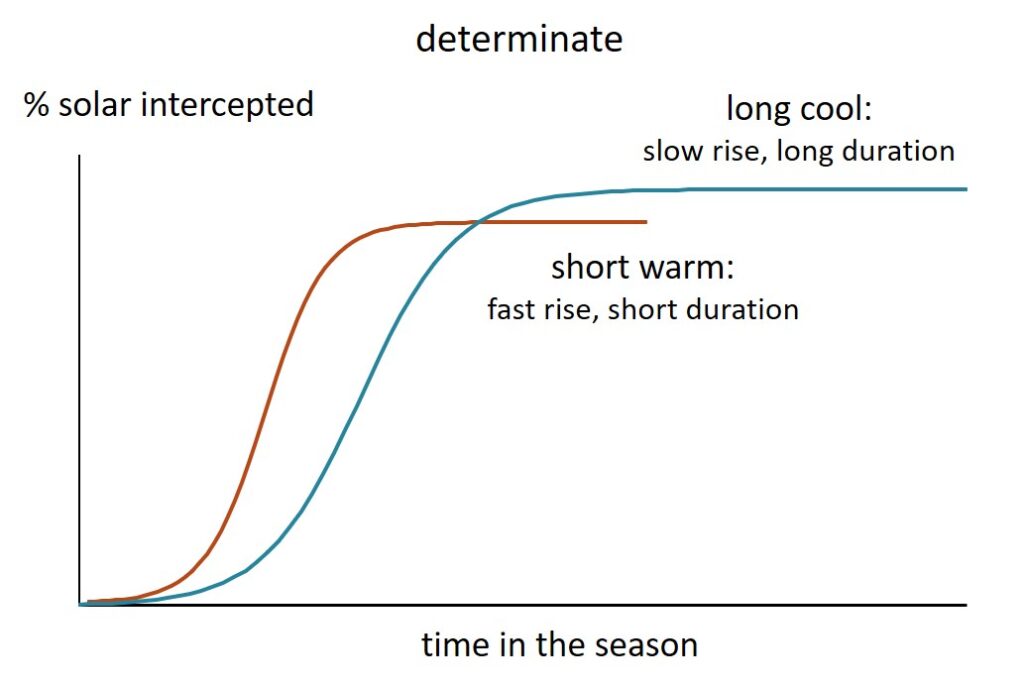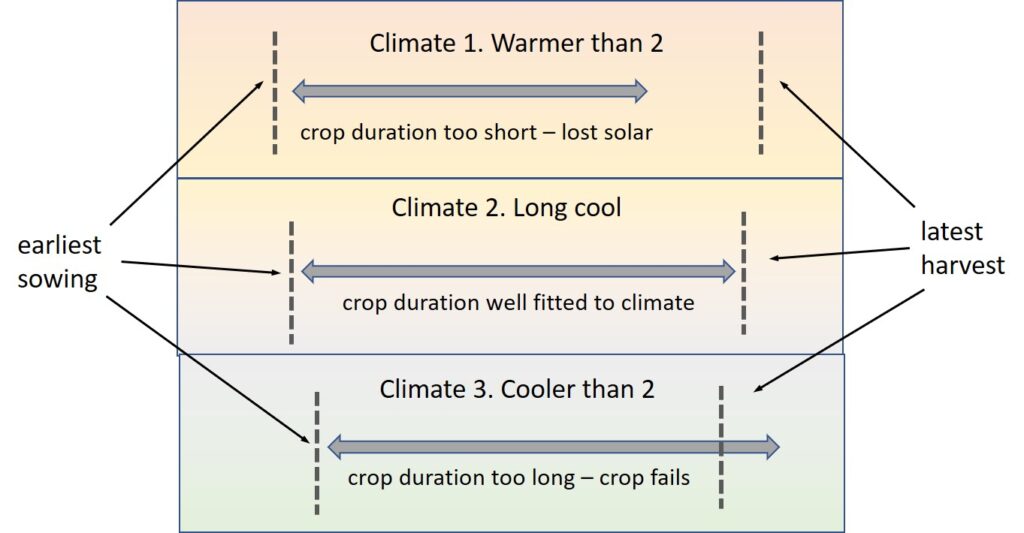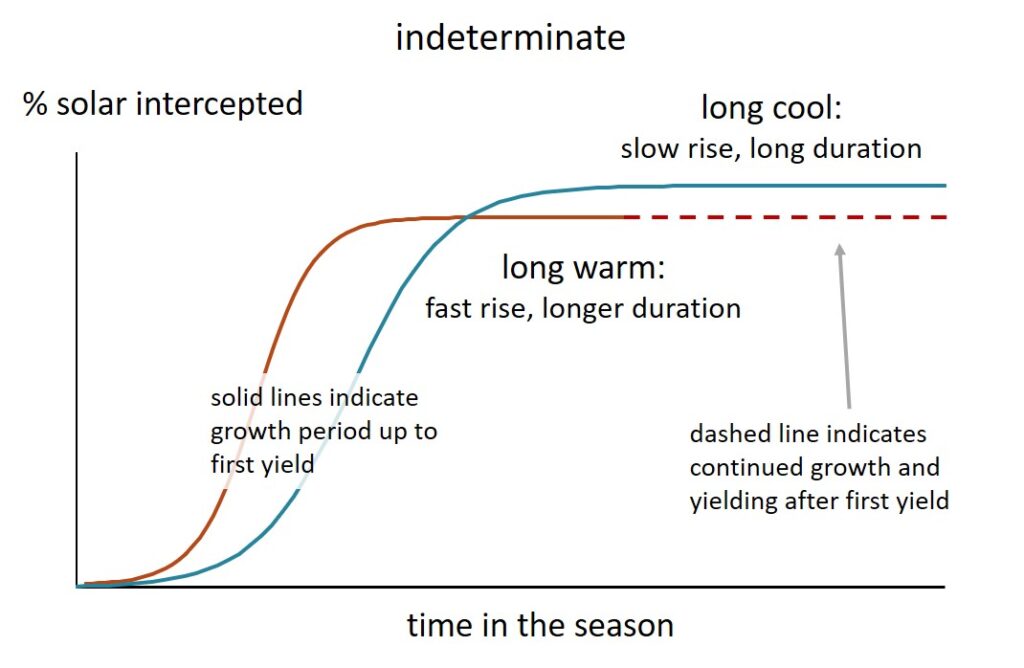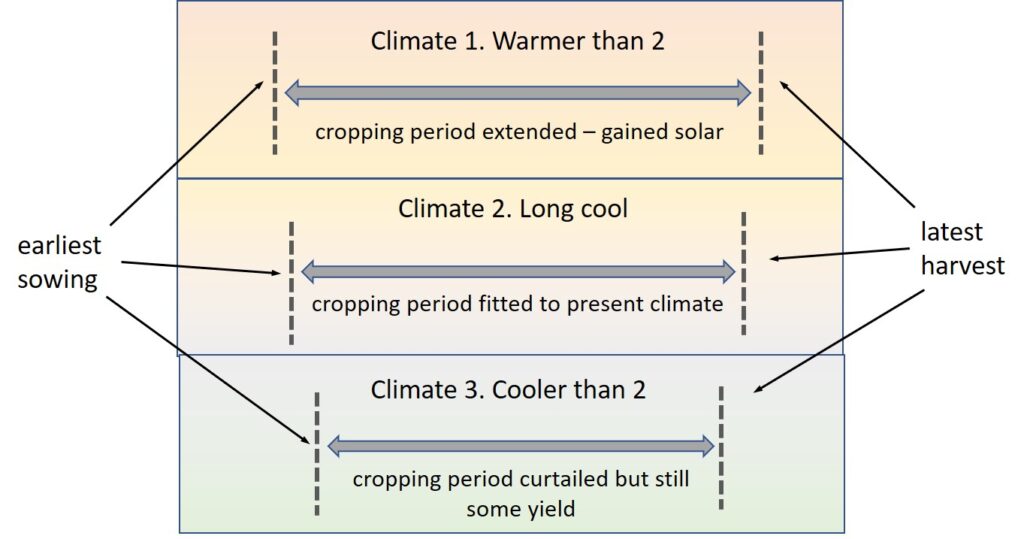Following background articles on the climatic factors of solar income and temperature [1] the story can now turn to the Long Cool Summer effect, the phenomenon that supports high agricultural productivity in the region. If future changes in temperature are to affect agriculture and local food supply, then they will do so by disrupting the Long Cool Summer effect.
There is a widespread belief that the climate in the northern parts of Britain is less supportive of agricultural production than in the south, but this is a misperception. Comparisons of cereal production among UK regions generally show yields (measured in tonnes per hectare, t/ha) are highest in lowland Scotland [2].
[CC6 in Climate and Crops – back to Climate and Crops summary page]
Summary
- Agricultural productivity is high at northern latitudes in Europe’s Atlantic climatic region.
- High productivity is due to a specific combination of factors – cool summers that allow long periods of plant growth and resource capture; high solar income spread over long days; adequate water and the absence of extreme heat and cold.
- A warming of climate by a few degrees would tend towards reducing yield in crops such as cereals, but might increase yield in grass and some crops of ‘open’ growth habit.
Global comparisons
If yields are high in lowland Scotland, are they also high in similar climates? Certainly, this appears to be the case from evidence summarised by the Food and Agriculture Organisation (FAO) [3].
The yields of cereals such as wheat are typically greatest in ‘cool-moist’ countries such as New Zealand and in similar climates of the northern Atlantic zone of Europe. Querying the FAO database [3] shows average wheat yields over the 20 years 2000-2019 were 9.04 t/ha in Ireland [4], 8.58 t/ha in the Netherlands, 8.17 t/ha in New Zealand and 7.89 t/ha in the UK. The comparable average for Scotland [2] was 8.29 t/ha. Yields of wheat in southern Europe and North America, for example, are much lower.
Of course, the crops would not yield without good agronomy, especially the provision of enough nitrogen for the target (protein) content of grain. But climate in the form of the Long Cool Summer is the basic reason for consistently high yields along the north east Atlantic seaboard.
Long and cool vs short and warm
For illustration (Fig. 1), the same crop species and variety is shown in two climates, differing in temperature but with the same incoming solar radiation. The crop in this example is determinate in that it has defined periods of vegetative and reproductive growth, at the end of which the crops is harvested. Cereals such as oats, barley and wheat are of this type.
As the leaves develop and expand, solar interception by the crop rises to a maximum at which it remains while the crop grows in weight and matures. The one in the warmer climate expands more quickly, but spends less time between maximum interception and grain maturity, than the one grown in the cool climate. Generally, in the cool climate, the longer period at maximum % interception more than compensates for the slower rise, so that overall, crops in the cool climate intercept more solar and produce more plant matter.
Fig. 1 Diagram comparing percentage solar interception by a determinate crop grown in two climates: a warm one, in which interception rises quickly but the crop matures earlier; and a cool one in which it rises more slowly but the period to maturity is longer.
The Long Cool Summer effect (though not in that name) is a general phenomenon, found in many parts of the world. In the tropics, yield of arable crops such as maize commonly increases with rise in altitude from a warmer to a cooler climate. One of the first and most comprehensive investigations into the effect was made along an altitudinal gradient on the slopes of Mt Kenya [5].
Combination of factors behind the Long Cool Summer
The Long Cool Summer effect depends on more than canopy expansion and duration as demonstrated in Fig. 1. A range of other climatic factors have to be in the right state also. Here are the main ones.
- Temperature is within a range that supports full germination, canopy expansion, growth, reproduction and maturity, but extends the main phases of crop bulking to maximise cumulative solar capture.
- Solar income is high in total during the main growing season, due mainly to long days at high latitude, but the sun’s intensity (energy received per second) is not so high that it ‘burns’ the plants or frequently over-saturates their light-capturing systems.
- Rainfall throughout the summer is enough to allow crops to be unstressed and to transpire freely and hence regulate their tissue temperature to prevent damage from over-heating.
- Risk is small of low temperature over the winter, or late in the season just before harvest, damaging crop or grass or preventing harvest.
- Risk is small of very high rainfall at any time in the growing season causing saturated soil or flooding that restricts oxygen availability to roots.
Combinations of the above typically occur in northern temperate regions between latitudes 50o and 60oN, having long summer days of 12 to 18 hours [1], and a moist oceanic climate with few extremes.
What happens if the climate changes?
Change in any of the factors in the list above can counter the Long Cool Summer effect. Fig. 2 shows how a slight warming or slight cooling can reduce yield. Three climates are represented. The (hypothetical) crop used for illustration is a short-season, determinate cereal such as barley, oats or wheat [6].
Climate 2 is the present one in which the long cool summer supports high yield in most years. Two dates are identified: the earliest time when the soil is warm enough to allow sowing; and the latest time at which harvest is possible before cold and wet weather prevents a crop from maturing. The period of possible crop growth between the earliest sowing and latest harvest is shown by the grey arrow. In a Long Cool Summer, a crop develops and intercepts resource for most of the available time.
Fig. 2 Representing three climates of increasing temperature. The distance between the vertical dashed lines indicates the period from first possible sowing to last possible harvest. Text gives explanation.
Climate 1 shows the effect of a warming on the existing cropping system. It allows earlier sowing and later harvest and (as in Fig. 1) promotes rapid crop expansion. However, the higher temperature shortens developmental phases and hence reduces the solar energy intercepted to build yield before grain maturity. Solar energy is in effect ‘lost’ towards the end of the season.
Climate 3 shows the effect of a cooling (or of an uncommonly wet year). Sowing is later and the low temperature extends crop development, but to an extent that the crop does not mature before the date of latest harvest. The crop fails.
Do all types of crop respond in the same way?
The effects of the climates in Fig. 2 were illustrated for the simplest case – a short season (e.g. spring sown) arable crop such as a cereal with a determinate growth habit and clearly defined date of maturity. Autumn-sown cereals are also determinate. A warming might allow them to survive better over the winter but will still shorten the period of grain filling in the summer and so reduce yield.
The question arises as to whether other types of crop and grass respond in a similar way. The important plant structural property is its determinacy – whether the plant’s growth in ‘closed’ and determinate or ‘open’ and indeterminate [6]. Fig. 1 and Fig. 2 above are reinterpreted below for an indeterminate crop such as grass for grazing or hay.
Fig. 3 Diagram presenting percentage solar interception for an indeterminate crop in cool and warmers climates. Text gives explanation.
In this comparison, the crop grows up to the point when yield can first be removed, but it then continues to grow, producing more yield. The curve of solar interception for the long cool climate is the same as that in Fig. 1, but the curve for the long warm does not stop at the end of the solid line. Rather, it continues (dashed red line) until the end of the growing season. The position is reversed from that for the determinate crop: a climatic warming increases growth and yield.
Fig. 4 The diagram in Fig. 2 reinterpreted for an indeterminate crop such as grass for grazing. Text gives explanation.
As in Fig. 2, the crop in the long cool summer (Climate 2) grows and yields within the time available. However, the crop in warmer climate (Climate 1) is not limited by the higher temperature – it starts to yield earlier but can take advantage of the longer period by continuing to grow and yield. Even the crop in the cooler climate (Climate 3) might fare better that the one in Fig. 2: if its indeterminate habit allows it to start producing before the latest harvest, then at least it will have yielded something rather than failed totally.
What are our indeterminate crops? Grass, managed for grazing or cutting, consists of indeterminate grasses and legumes (though the latter are now rare). A warming could actually increase yield of grazed pastures – being indeterminate, the plants have more time to produce new leaf and reproductive structures and hence more time to be eaten by livestock (provided warming does not also bring lower rainfall – see comment below). The position for grass cut for silage is less certain – growth during the season is indeterminate, but the need for the grass to dry after cutting makes it partly determinate.
Some arable crops are also indeterminate, or partly so, in that they continue growing throughout the main season. In the case of potato, which functions in this way, the open nature of the plant’s growth is usually stopped in today’s farming by a herbicide spray to kill the foliage and allow harvesting. In principle, a warming would increase the yield of such crops.
Cautionary note
These simple descriptions of the effect of a climatic warming assume the warming is not so great as to harm plants directly. If the warming is confined to 2 or 3 degrees then it should affect the rate of plant development as indicated, but not push the plants into the harmful zones defined in the previous article on Temperature [1].
The descriptions also assume that the warmer climate has the same amount of rainfall as the present one and ignore the increase in gradient for evaporation of water between plant and air that is typical of warmer conditions. Warmer air is – as far as plants perceive it – also drier. At the other extreme, a wet end-of-summer might also cause reduced or failed yield, for example, if continued wetness prevents harvest of cut hay. Future articles will examine whether drier conditions in summer would lead to more ‘lost solar’ in Fig. 2 and reduce the gained solar in Fig. 4.
Conclusions
The above are some examples of the way crops and grass – presently yielding in a Long Cool Summer climate – might respond to a small change in temperature of several degrees. Not all crops and grass will be affected in the same way. There will be no single or uniform response except where only one type of crop is grown.
Farming and the food system can prepare for a change in climate by ensuring greater diversity in crops and grass: more species and varieties, and in particular a greater mix of types with different life cycles and growth habits. Farming may adapt by introducing varieties that better fit a new climate, but effective agronomy also has to be in place to maintain soil quality and plant nutrient supply and to limit the damage due to weeds, pests and diseases.
[Future articles will examine the effect of specific climatic events – such as the hot-dry 1976 and the cold-wet 2012 – that perturbed our long cool summers.]
Sources | References | Links
[1] For background, see previous articles on Solar income, Under the cloud and Temperature.
[2] Yields and areas of the main crops are summarised annually for the UK as a whole by Department for Environment, Food and Rural Affairs (Defra), for example: Farming Statistics – final crop areas, yields, livestock populations and agricultural workforce at 1 June 2020 United Kingdom. Those for cereals in Scotland, both totals and split into regions, are provided by Scottish Government, for example at Cereal and oilseed rape harvest: final estimates 2020. Comparisons of yields among UK regions, allowing comparison of lowland Scotland with southern England, are less easy to locate!
[3] The Food and Agriculture Organisation of the United Nations summarises production by country, data being available online through their FAOSTAT web pages. Click crop, species, country, years, etc. to get yield as an output file.
[4] Comments on high wheat yields in Ireland are in the magazine Farmers Weekly at High wheat yields: why the Irish excel and Ireland leads the world in wheat yields (but beware, access is restricted and advertisements appear!).
[5] One of the first documented examples of the mechanism behind the Long Cool Summer effect was that for maize on the slopes of Mount Kenya. Moving from warmer to cooler altitudes extended the duration of crop production, while incoming solar was little affected. Crops intercepted more solar radiation and produced more dry matter and yield. References: Cooper PJM. 1979. The association between altitude, environmental variables, maize growth and yield in Kenya. Journal of Agricultural Science, Cambridge, 93, 635-649; Hawkins RC, Cooper PJM. 1981. Growth, development and grain yield of maize. Experimental Agriculture 17, 203-207.
[6] The state of being determinate or indeterminate is explained in the article Life cycle | growth habit | uniformity. Domestication of cereal crops from wild plants enforced a ‘determinate – synchronous’ growth habit to ensure a crop would mature at a specified time within the agricultural year. Most grasses and forage legumes have remained indeterminate.




